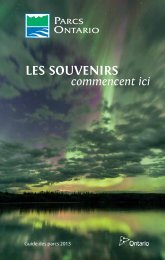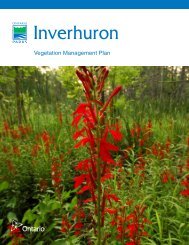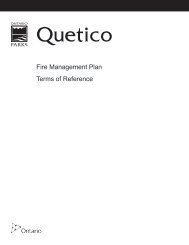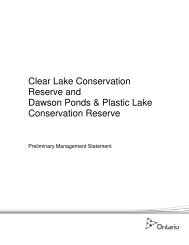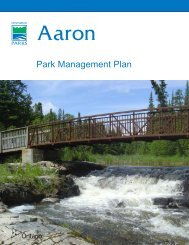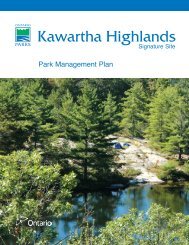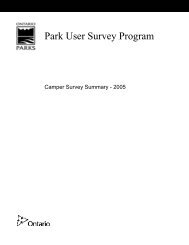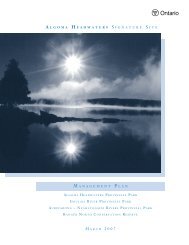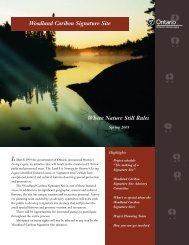Vegetation Plan - Ontario Parks
Vegetation Plan - Ontario Parks
Vegetation Plan - Ontario Parks
Create successful ePaper yourself
Turn your PDF publications into a flip-book with our unique Google optimized e-Paper software.
4.0 MANAGEMENT UNITS AND PRESCRIPTIONS<br />
The Inverhuron Park Management <strong>Plan</strong> outlines general vegetation management policies (See Section 1.2),<br />
which have provided the basis for the more detailed prescriptions outlined here, based on vegetation<br />
management issues and vegetation communities found throughout the park. Section 4.1 outlines general<br />
management prescriptions that may be implemented throughout the entire park, whereas section 4.2 outlines<br />
management prescriptions for specific vegetation management units within the park.<br />
Site conditions prior to the implementation of species and habitat specific management prescriptions should be<br />
well documented (i.e., presence of invasive species or species at risk) (Appendix 1). General management<br />
prescriptions carried out as part of regular park maintenance such as lawn mowing and dead and hazardous<br />
tree removal do not require the same documentation. An adaptive management approach will be taken when<br />
implementing vegetation management prescriptions to allow for modifications as necessary to ensure success.<br />
4.1 General Management Prescriptions<br />
4.1.1 Dead and Hazardous Trees<br />
Safety will be the major deciding factor for when a tree needs to be removed, however, consideration must also<br />
be given to the importance of dead tree material and downed woody debris. Dead trees will be left standing as<br />
wildlife habitat for cavity-nesting birds and mammals in all zones at the superintendent’s discretion except in<br />
instances where they pose a direct threat to public safety (OMNR 2003) and with the exception of situations<br />
where their presence:<br />
• Obstructs efforts to maintain recreational facilities, roads, campsites, trails, day use areas, manicured<br />
lawns and the pioneer cemetery;<br />
• Results in park visitors scavenging wood for camp fires;<br />
• Encourages insect infestations that may be detrimental to the health of the forests.<br />
Material that has been removed from a site can be used as firewood or could be chipped and used to help<br />
reduce erosion, or to build up an organic layer in newly developed areas.<br />
Further guidance on the treatment of dead and hazardous trees is found in Appendix 2.<br />
4.1.2 Herbicide Use<br />
The Inverhuron Park Management <strong>Plan</strong> does not address herbicide use. Herbicides that biodegrade quickly,<br />
have low soil activity and have been tested and shown to have minimal environmental impacts (e.g., glyphosate<br />
and triclopyr) (OMNR 2001) can be used for restoration activities and controlling invasive species. Use of<br />
biological control agents (if available) will be used when feasible. Use of herbicides for restoration activities and<br />
controlling invasive species will be done in consultation with the zone ecologist to determine their<br />
appropriateness. Any person working with herbicides in the park must do so under the requirements of the<br />
Pesticides Act and PM 2.16, Use of Pesticides and Herbicides in Provincial <strong>Parks</strong>.<br />
Species such as Poison Ivy (Rhus radicans) may be controlled in the development zone and in other zones<br />
where park visitors may come into contact with the plant (i.e., trails) as deemed necessary. Glyphosate is<br />
currently the best control for Poison Ivy (OMNR 2001).<br />
8



